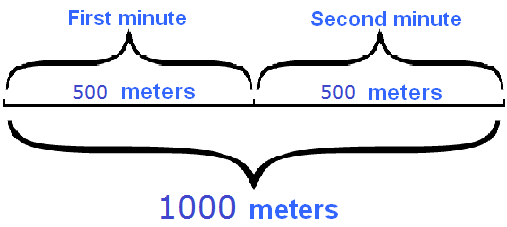In this lesson we will look at three physical quantities: distance, speed, and time.
Distance
We have already studied distance in the units of measurement lesson. Simply put, distance is the length from one point to another. (Example: the distance from home to school is 2 kilometers.)
When dealing with long distances, they will mostly be measured in meters and kilometers. Distance is denoted by the Latin letter S. You can also denote by another letter, but the letter S is generally accepted.
Speed
Speed is the distance traveled by a body in a unit of time. A unit of time is one hour, one minute, or one second.
Suppose that two students decided to compete and run from the yard to the playground. The distance from the yard to the playground is 100 meters. The first pupil runs in 25 seconds. The second one ran in 50 seconds. Who is the fastest student?
The one who ran the greater distance in 1 second is the fastest. He is said to have more speed. In this case, the speed of the students is the distance they run in 1 second.
To find the speed, you have to divide the distance by the time of movement. Let's find the speed of the first schoolboy. To do this, divide 100 meters by the time of movement of the first schoolboy, that is, by 25 seconds:
100 m : 25 s = 4
If distance is given in meters and travel time in seconds, speed is measured in meters per second (m/s). If distance is given in kilometers and travel time in hours, speed is measured in kilometers per hour (km/h).
We have distance in meters and time in seconds. So the speed is measured in meters per second (m/s).
100 m : 25 s = 4 (m/s)
So, the speed of the first student is 4 meters per second (m/s).
Now let's find the speed of the second pupil. To do this, divide the distance by the time of movement of the second student, i.e., by 50 seconds:
100 m : 50 s = 2 (m/s)
So the speed of the second student is 2 meters per second (m/s).
The speed of the first student is 4 (m/s)
The speed of the second student is 2 (m/s)
4 (m/s) > 2 (m/s)
The speed of the first student is faster. So he got to the playground faster. Speed is denoted by the Latin letter - v.
Time
Sometimes there is a situation where you want to know how long it takes the object to cover a particular distance (travel that distance).
For example, it is 1000 meters from the house to the sports club. We need to get there on a bicycle. Our speed will be 500 meters per minute (500 m/min). How long will it take us to get to the athletic section?
If we will travel 500 meters in one minute, how many such minutes (with five hundred meters each) will be in 1000 meters?
Obviously, we have to divide 1,000 meters by the distance we travel in one minute. That is, 500 meters. The result will be the time in which we will reach a sports club:
1000 : 500 = 2 (min)

The time of movement is denoted by the small Latin letter - t.
The relationship of speed, time, distance
Speed is usually denoted by the small Latin letter v,
time of movement by the small letter - t,
the distance traveled by the small letter - s.
Speed, time and distance are related to each other.
If you know the speed and time of movement, you can find the distance. It is equal to speed multiplied by time:
s = v × t
For example, we left the house and went to the store. It took us 10 minutes to get to the store. Our speed was 50 meters per minute. If we know our speed and time, we can find the distance.
If we walked 50 meters in one minute, how many of these 50 meters will we walk in 10 minutes? Obviously, by multiplying 50 meters by 10, we will determine the distance from the house to the store:
v = 50 (m/min)
t = 10 minutes
s = v × t = 50 × 10 = 500 (meters to the store)
![]()
If time and distance are known, you can find the speed:
v = s : t
For example, the distance from home to the school is 900 meters. It took the student 10 minutes to reach the school. What was his speed?
The speed of a schoolboy is the distance he travels in one minute. If he traveled 900 meters in 10 minutes, what distance did he travel in one minute?
To answer this one, you have to divide the distance by the time of the schoolboy's movement:
s = 900 meters
t = 10 minutes
v = s : t = 900 : 10 = 90 (m/min)
![]()
If you know the speed and distance, you can find the time:
t = s : v
For example, we have to walk 500 meters from our house to the sport club. Our speed will be 100 meters per minute (100 m/min). How long will it take us to reach it?
If we walk 100 meters in one minute, how many such minutes with 100 meters are in 500 meters?
To answer this question we need to divide 500 meters by the distance we will walk in one minute, that is, by 100. Then we will get the time in which we will reach the sports section:
s = 500 meters
v = 100 (m/minute)
t = s : v = 500 : 100 = 5 (minutes to the sports section)
2. If you find an error or inaccuracy, please describe it.
3. Positive feedback is welcome.